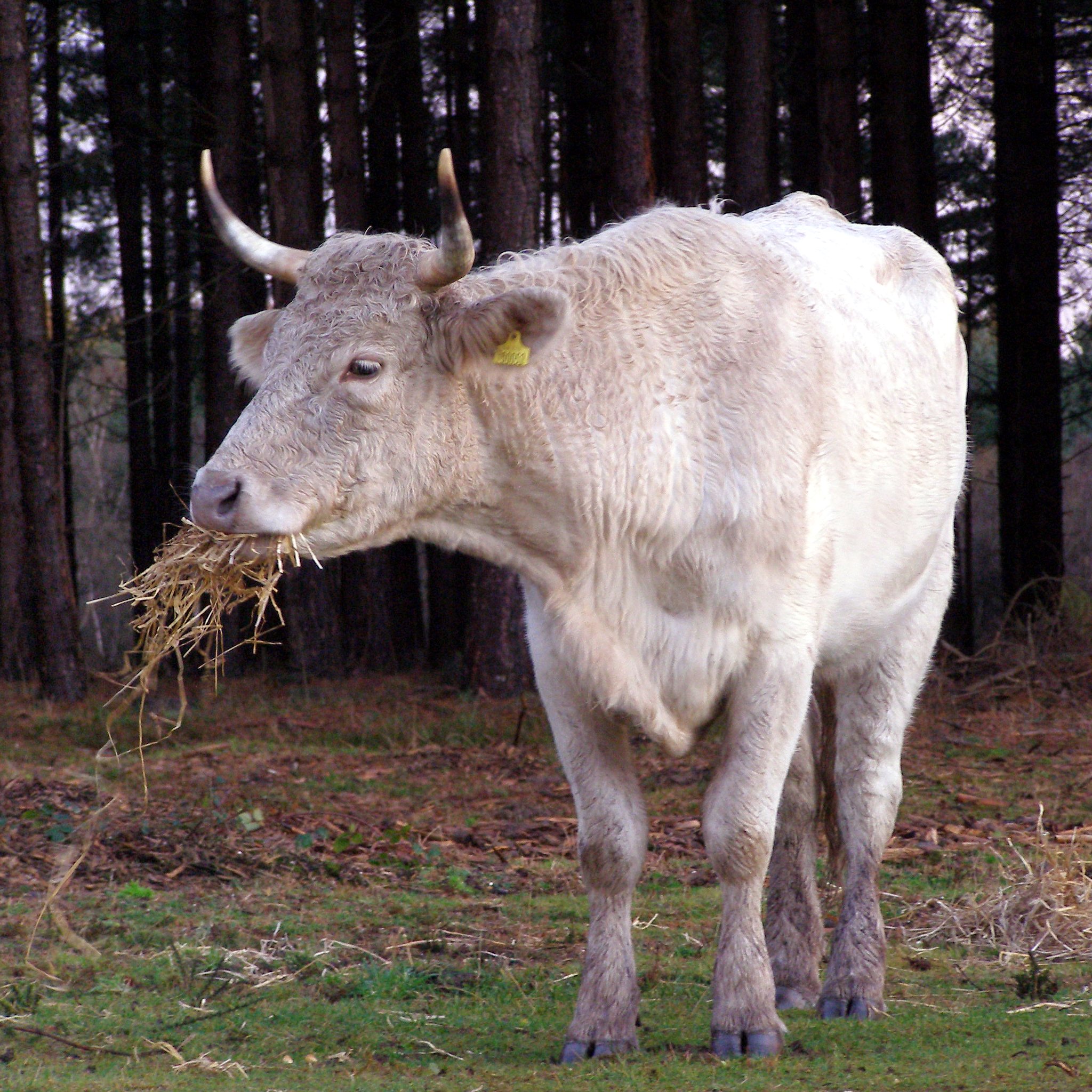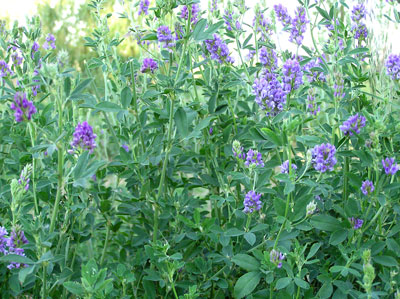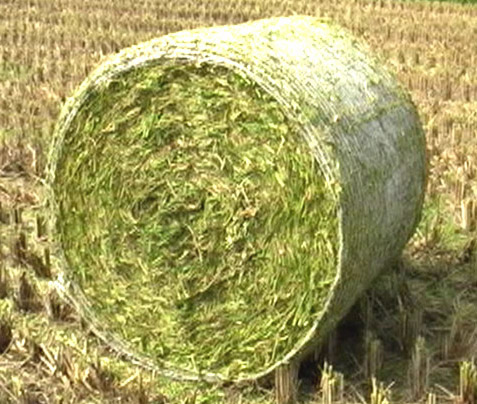In this post we begin by explaining the concept of feeding strategy. Two basic strategies, total mixed ratio and partial mixed ratio, are discussed. We then move on to feeding heifers and lactating cows, with extra attention being paid calving time. Lastly we review some aspects about feeding and cow health.
 |
A feeding strategy is a combination of the feeds used and the machinery and methods used to prepare and distribute the feed. Selection of a feeding strategy depends on
- The genetic potential of the cattle
- Production targets, possible production quotas
- Location of the farm (available fields, distance from fields and distance from other sources of cheap feed, i.e. bakeries and breweries)
- Health and welfare of the animals
- Herd size
- Buildings and machinery available for use
- Number and skills of workers available
- Available feeds and their prices (connected to the location of the farm)
- Digestibility and quality of the feeds grown in-farm
- Production type (normal / organic / biodynamic)
Several studies show that TMR and PMR are equally effective in terms of milk yield. With TMR the increase of eating potential after calving is more stable than with PMR, but the total intake of feed is not affected by the feeding strategy. TMR may decrease the changes of rumen pH during changes in feeding. Altering the TMR may not be necessary during lactation, because cows in late lactation do not gain excess weight even when fed with the same mic than cows in the early lactation. Number of feeding times in a day does not affect milk yield, but feeding only once decreases the utilization of the feed. TMR may also decrease illnesses throughout the lactation (perhaps due to the stabilizing effect on rumen pH).
Heifers
A good dairy cow is the result of a successful heifer rearing. Today, most female calves are needed as replacements due to high percentage of culling and young age of the culled animals. Rearing calves and heifers is expensive, but vital for maintaining the productivity of the farm.From birth to 3 months, when the udder tissue develops isometrically, female calves are fed ad libitum.
Feeding ad libitum helps the calf to utilize her full genetic potential. From 3 moths until 10-12 months the udder develops faster than other tissues, and strong feeding disrupts that growth by increasing fat tissue and decreasing the amount of secreting tissue. High-energy diet for heifers may decrease their milk yield up to 52 %, but the scientific results are not unambiguous. It is recommended that Holstein heifers shouldn't grow more than 650-900 g/day and Ayrshires 600-800 g/day. Slow growth is not harmful, but increases costs and offsets the optimal time for 1st insemination (15 mo) and calving (24 mo).
 Heifers of 3-12 mo of age can be fed with straw, hay, grass, silage, or kept on pasture. Silage with a high D-value should be avoided, and concentrate (max 2 kg/day) should be given only if needed. Weight of the heifers should be measured for example by measuring the girth of their chest. Feeding affects the weight and the width of the hip of the heifers, but does not have impact on their height at withers or the width of the body. To ensure healthiness, minerals and vitamins must be made available. Once the heifer reaches sexual maturity, the growth of the udder decreases. Sexually mature heifers can be fed more freely without adverse effects on their growth or production.
Heifers of 3-12 mo of age can be fed with straw, hay, grass, silage, or kept on pasture. Silage with a high D-value should be avoided, and concentrate (max 2 kg/day) should be given only if needed. Weight of the heifers should be measured for example by measuring the girth of their chest. Feeding affects the weight and the width of the hip of the heifers, but does not have impact on their height at withers or the width of the body. To ensure healthiness, minerals and vitamins must be made available. Once the heifer reaches sexual maturity, the growth of the udder decreases. Sexually mature heifers can be fed more freely without adverse effects on their growth or production.The correct time for insemination is determined by the breed and weight of the heifer. Large breeds should be allowed to grow larger prior to insemination. Otherwise their 1st lactation will be unproductive, because most of the energy is needed for the animal's own growth instead of milk production. Calvings may also be problematic if the dam is still too small. Ayrshires should be at least 14 months of age at the insemination, weigh over 320 kilos and have a chest girth over 158 cm. The same values for Holsteins are 15 mo, over 340 kg and over 162 cm. As a comparison, for a Finnish landrace the target weight is > 240 kg and chest girth 140 cm due to the small adult size of the breed. Note that a heifer is not in its adult weight until at 5 years of age - after 3 calvings!
 |
| Recommended daily grow for heifers (data from several sources). |
To summarize, heifers should be fed in different phases. From 3 - 12 months and during the first six months in gestation the feeding should be limited. From 12 months to fertilization the heifers are fed to ensure the correct weight on insemination. The last months of gestation the heifers are again fed to support their healthy growth and a correct BCS. During the last weeks of gestation, the heifer is introduced to the feeds and concentrates of cows to get her ready for her first lactation.
 | ||
| Measuring a heifer. (c) Land O'Lakes, Inc. |
Cows
There are several strategies for dairy cattle. In feeding per norms there are two options: individual feeding per norms, where the amount of concentrate is tailored for each animal based on their last measured milk yield (may be automatic if milking robots and concentrate kiosks are used). In an applied feeding per norms -strategy the amount of concentrate is increased during the production peak, and then returned to a normal level. In both strategies silage is freely available, but the amount of concentrate is based on a predicted or measured milk yield. Equal concentrate -strategy means that each cow gets the same amount of concentrate during a certain production stage. Silage is freely available, so the cows use it to adjust their energy intake. At the end of lactation each cow may be fed individually as per their current BCS. Equal concentrate can be used for each individual animal, or by tailoring the concentrate amounts per herds or animal groups (dry cows, pregnant heifers etc). Both strategies are equally effective.Note that when fed freely, there must be 10-15 % of the feed left over! If the animals eat everything, it is a clear indication that they are not receiving enough feed. Leftovers can be then fed to weaned calves, heifers, growing bulls or to dry cows, who in general are less picky than lactating cows. High-quality silage can be offered even to unweaned calves to get them aquainted with the taste and feel of "real food".
Addition of concentrate has different production responses depending on the phase of lactation. In early lactation increasing the amount of concentrate increases milk yield more than in the late lactation, but only during the early phase. If the portion of concetrate is increased quickly, milk yield can be increased up to 3 kg / day during the first 5 weeks (Kokkonen 2004). There is no impact to the milk yield in mid or late lactation.
 |
| (c) Wikipedia Commons |
After calving cows utilize their own tissues to produce enough nutritients to their milk. This leads to weight loss and a decrease in BCS. The more heavily the cows were fed during early gestation the more weight they lose in early lactation. Weight loss is also connected to limited feeding during early lactation. Due to effective tissue mobilization there is no decrease in milk yield even if the amount of concentrate is low. However, these cows may yield less milk during the entire lactation, and have lowered fertility after the lactation. Therefore it is advised to offer at least enough concentrate during the early lactation.
Feeding and calving
Calving begins a major change in the nutritional requirements of the body. The udder requires three times more glucose, twice more amino acids and 4-5 times more fatty acids than the developing embryo did. If the pregnant cows are fed heavily before calving, they suffer from many adverse effects during early lactation. There are more non-esterized fatty acids (NEFA) in their bloodstream, which indicates a high level of tissue mobilization. During the first month of lactation, 40-50 % of the fats in the milk are tissue-based.When there's a large amount of NEFAs in the blood, the animal's body cannot effectively use them all. Fats begin to accrue in the liver, which again hinders the functions of the liver even further. This may lead to fatty liver. A fatty liver cannot produce glucose as much as the cow needs (glucose is the main source of lactose in the milk). To replace the glucose the cow needs, she again utilizes her body and uses fats as an energy source. This leads to weight loss and ketosis, since using fats in high amounts as energy produces harmful metabolites.
Both a fatty liver and ketosis are caused by metabolic stress. Metabolic stress is natural after parturition in all mammals, but due to breeding, the stress is harmfully high for dairy cows. The stress decreases fertility and immunity, making the animal more vulnerable to opportunistic pathogens and diseases such as mastitis. Diseases caused by metabolic stress are the main cause for culling cows. One could say that we have, while selecting cows based on their high productivity, bred cows for fast culling. It should be crystal clear that breeding and animal management must focus on increasing the health and endurance of cows. Luckily in some areas, like in the Scandinavia, this has been the aim of cow breeding for decades.
Breeding alone cannot do much to prevent metabolic stress without decreasing milk yield considerably. Faster and better options are to
- Keep the BCS of cows at 3 - 3,5 before calving
- Provide enough high-quality silage after calving
- Provide enough cereal-based concentrate in the early lactation
- Minimize all stress before calving, ensure the cow is in a safe and clean pen
- Provide enough protein before and after calving (120 - 130 g/ kg DM) to reduce the need to draw calcium from the bones and other tissues. In maize-based feeding protein addition is not necessary.
- Alternatively, reduce protein prior to calving to "teach" the cow's body to utilize its own Ca effectively, and provide enough Ca after calving to replace the losses.

Maintenance of health and production
Once a farmer has achieved a good level of feeding costs versus income from milk yield, it is time to maintain that situation or even improve it. The overall situation of the herd can be estimated from various indicators.Comparing the yearly milk yield of the entire herd or single cows to local averages is a good way to see how the farm measures against its "competitors". Annual amounts of milk, protein and fat produced also show the development of the farm. Lifetime production is also a good measure for endurance of the cows. Different cost structures should also be analyzed annually. Comparisons should not be made to farms from others countries, unless you are certain the results are calculated similarly.
Technology offers both invasive and non-invasive methods for monitoring cow's health. Rumen pH can be measured with an automated bolus (by Smaxtec) installed in the rumen, and ruminating can be measured with a simple noseband by RumiWatch. While the bolus may sound dubious, it does not affect the functions of the rumen at all. In fact, after slaughter, items such as scarves, wallets, hats and even a hammer have been found from the rumen of an old cow!
Milk properties can also give hints about the cow's health. Milking robots can measure somatic cell count, conductivity and hormone levels from the milk. Urea is another component which can be measured. It is a by-product of normal protein metabolism, and is present in milk and in blood by the same amounts. The analysis of urea is usually done in the dairy or a laboratory, because specific devices are needed. Urea can be used to estimate the levels of proteins in the feed: if the urea content is high (> 40 mg/100 ml) , the animal cannot utilize all of the nitrogen it receives from feed. If the content is low (< 20 mg/100 ml), added amino acids may be necessary.
All this information should be used wisely, but not rely solely on it. One should also remember that the point is not to rear cows at the razor's edge between highest possible production and metabolic illness!















